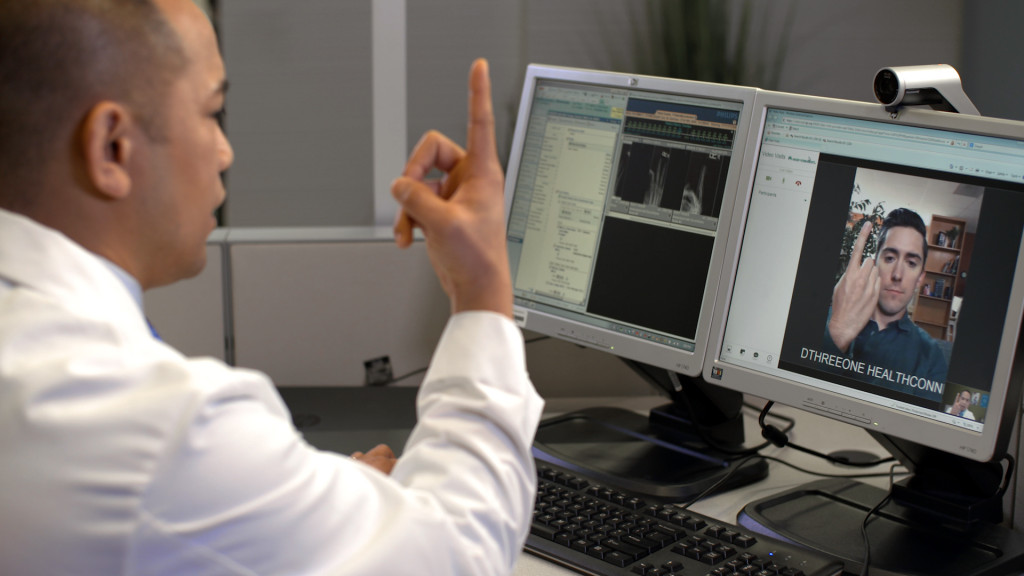The coronavirus pandemic has sparked an incredible spike in telemedicine across the Bay Area, allowing doctors and nurses — even those under quarantine themselves — to continue seeing patients who are stuck at home.
Literally overnight, the coronavirus has fundamentally shifted how people receive and deliver routine medical help. And the numbers that tell the story are mind-boggling: Video visits for Sutter Health patients in Northern California have multiplied an eye-popping 175 times since the onset of the COVID-19 pandemic. Stanford Health Care’s use of digital visits has soared by 50 times — from a few dozen a day before the virus hit to 3,000 a day now. And Kaiser, already a leader in video appointments, doubled its online visits.
“I don’t think we’ll ever go back to where we were,” said Craig Wargon, a physician at Kaiser Permanente in Santa Clara and medical director of The Technology Group, a regional department that develops ways for patients and medical professionals to interact online. “This will probably change the entire medical system.”
Kaiser and other health care systems have for years offered online visits — either by phone or video — for everything from flu and common colds to skin conditions and physical therapy. Even with the option, many patients preferred in-person visits. But health care experts say, propelled by the historic stay-at-home orders, that is sure to change.
Under ordinary circumstances, Kayla Maloney of Scotts Valley would’ve brought her two-month-old daughter, Evie, into her doctor’s office in Santa Cruz for a routine checkup. But because of the coronavirus, she opted to try an online appointment for the first time.
“It was great,” she said, adding that “the only downside” was that her daughter wasn’t able to be weighed or measured.
And, she said, it was easy to join a video chat accessed through Kaiser’s app on her phone.
That’s a message medical professionals want to get out to older people, especially, who appear to be more at risk of dying from the coronavirus than younger people. Where an older parent might need a little help, some health care systems will allow adult children or caregivers to set up proxy access, so they can email doctors and see lab results and other medical information.
If doctors need a high-quality visual of something, such as a rash or other skin condition, they can ask patients to send them a photo.
While some things require an in-person visit, from vaccines to broken bones to infections, the more visits can be conducted at home, the better it is for the hospitals and clinics fighting to limit the spread of the pandemic and the less personal protective equipment like masks and gloves they have to use.
“We are learning new ways to deliver care via telehealth – from acute respiratory illness to everyday complaints such as the flu or urinary tract infections to the management of chronic disease,” Albert Chan, a doctor and chief of Sutter’s Digital Patient Experience, said in an email.

The Trump administration in March loosened telemedicine regulations, allowing all Medicare patients — not just those in rural areas — to choose virtual visits. The government also relaxed enforcement of the health privacy law, HIPAA, raising concerns among privacy advocates but making it easier for providers to offer telemedicine.
As more patients have warmed to the idea, so have more doctors.
“Frankly, we had a little bit of a hard time convincing them this was worthwhile to try,” Wargon said of some of his Kaiser colleagues, even though they’ve been receiving training in telemedicine for years. “But now that we’re in this situation, I’m surprised at how easily this has been adopted.”
And it’s not just doctors going online. Sahana Baker-Malone, co-owner of the pediatric occupational therapy clinic Development Is Child’s Play, is surprised, too. Her team serves children with autism, including some who are nonverbal, and kids with sensory processing disorders.
“I never imagined I could do my job remotely,” Baker-Malone said. “But necessity is the mother of invention.”
Several weeks ago, the Cupertino-based clinic moved its appointments online. And while there was some initial pushback, she said, “It’s actually surprisingly possible in a realm we never imagined.”
Typically, a child would come into the clinic and a therapist would work on various skills meant to make daily life a little easier using balls, swings — which help kids strengthen their movements and balance — and other tools. Even though many families don’t have all of those tools on hand, the online appointments have provided a valuable window into clients’ home environments and a chance to be creative. Two parents or adults swinging a child between them — one holding the feet and one holding the arms — can give that kid valuable sensory input, for instance, Baker-Malone said.
“We’re getting to participate in their normal life as opposed to bringing them into our clinic, where we see kind of constructed sessions,” she added.
Lara Sandora’s 11-year-old son, Niklas, is autistic and mostly nonverbal. He’s been going to Development Is Child’s Play for years and, like other clients, recently moved to online appointments. His speech therapist and music therapy class are also virtual now.
“We had no idea what to expect,” Sandora said. “We were shocked at how well he responded to somebody he knew in the screen.”
While Sandora plans to take him back to the clinic when it’s safe, the explosion of online options — and knowing that they are workable — has been a lifeline for a family that has typically stayed pretty close to home and kept routines. The idea that they could travel and do an online appointment while they are gone, rather than having to come back early or skip therapy, “is mind-blowing,” she said.
“The fact that I can do a fitness class, watch a theater production, get takeout from a white tablecloth restaurant … all of those things are actually huge wins for a family like us with special needs,” Sandora said.
Going remote hasn’t just helped patients and clients, it’s also helped doctors and nurses. In a blog post, Stanford Medicine said virtual visits allow physicians and staff who have been exposed to COVID-19 to continue working even while quarantined.
And telemedicine is translating to billions of dollars a year for health care companies. It’s cheaper to deliver because it can both keep patients from the ER and attract others to lower-cost appointments they would otherwise avoid.
As technology — from algorithms to artificial intelligence — evolves, more types of online visits will be possible, including remote monitoring of conditions like diabetes, where data on everything from blood pressure to weight can flow directly into a patient’s electronic medical records.
“We still like to offer choice,” Wargon said. But “we will be doing more of that kind of thing.”










